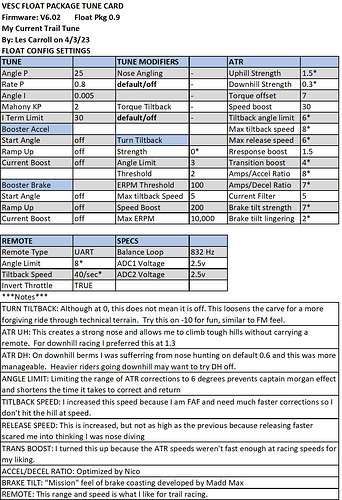NOTE: THIS IS NOT STEP ONE. IF YOU ARE NEW TO VESC, YOU NEED TO HAVE A FULLY FUNCTIONING BOARD BEFORE PLAYING WITH TUNES.
Here are my settings after race weekend. This will be my trail tune going forward and I will only need to make a couple adjustments as the terrain demands. At Spider Mountain for the downhill racing, ATR UH was at 1.3 and DH at 0.3, and I had a slight nose down angle. For rides around Reveille Peak Ranch with lots of tech and climbs, I raised my nose half a degree and set ATR UH to 1.5. I ran a remote most of the time and have limited my ramote tilt range to a realistic use of 8 degrees and a speed of 40-ish degrees/sec. I found this speed easy to manage pump tracks and berms without affecting my balance. I hope this helps other aggressive riders!
I thought your claims about turntilt were interesting so I checked out the code. Strength of 0 does indeed deactivate turntilt with this statement at the beginning of the apply_turtilt() function.
if (d->turntilt_strength == 0) {
return;
}
Setting strength to negative should nose down but there are some interactions with ATR that I am not clear on.
Thanks for sharing your ATR settings. I will give these a try.
I tried -10 turn tilt per your suggestion and it does feel good. When carving, I believe this causes acceleration around the apex of the carve due to the nose dipping and shifting my center of gravity slightly forward. I always felt that the nose lifting during turn tilt was the opposite of what I wanted.
The negative affect, of course, is the nose dipping which will cause issues on trails and pump track. To counter this and maintain the acceleration effect through the carve, I have changed the booster to be based on board roll instead of pitch. This allows you to lean harder into carves and rely less on tilt input to keep the nose up because you won’t have to push down as hard. I think this will be particularly useful for going hard into banked turns on pump tracks.
If you are interested, I could use your help in determining if this new booster captures this effect properly and if you see it as a valuable feature. I plan to post a package that includes this next week.
Thanks for your insights!
Right on! Yeah the software recognizes this as “off” as a technicality, but it feels like it is just one place on a sliding scale of stiffness. Whereas +1 is marginally stiffer than 0, and -1 feels a little looser than 0. Although I can’t rule out Placebo effect lol
I have been told the whole booster aspect may get scrapped, as it is not performing as it should. The output of current measured does not reflect the booster settings, so I have stopped using booster and placed that energy into the PID settings instead. I know that downhill turns with ATR downhill can create that nose-hunting feel, and that is where having a higher value like +6-10 can help keep the nose up, but it also makes all turns and bumps more reactive. At the end of the day, carrying a remote makes on the fly adjustments so much easier to manage.
